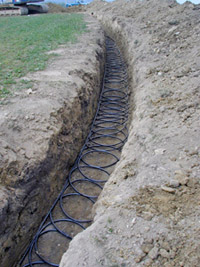
Geothermal heat pumps take advantage of the relatively constant temperature of the ground as a heat source and a heat sink to provice both heating and cooling for homes and offices. A liquid refridgerant is pumped from the outside to the inside carrying heat from one area to the other in much the same way that a refridgerator works - i.e the fridge is cold outside, but the back of the fridge is hot (heated by the warmth removed from inside.
A substance called a refrigerant carries the heat from one area to another. When compressed, it is a high temperature, high-pressure liquid. If it is allowed to expand, it turns into a low temperature, low pressure gas. The gas then absorbs heat.
In the winter the normal heat pump system extracts heat from outdoor air and transfers it inside where it is circulated through your home's ductwork by a fan.
Even cold air contains a great deal of heat; the temperature at which air no longer carries any heat is well below -200 degrees Fahrenheit. But the coldest temperature ever recorded in the lower 48 states was -70 degrees, recorded at Roger Pass, Montana on January 20, 1954. Obviously in such weather, a heat pump would have to work pretty hard to produce 68-degree temperatures inside your home.
That's why geothermal heat pumps are so efficient.
Geothermal heat pumps are similar to ordinary heat pumps, but instead of using heat found in outside air, they rely on the stable, even heat of the earth to provide heating, air conditioning and, in most cases, hot water.
There are three basic alternative geothermal heating systems - vertical, horizontal, or open loop. In a vertical system a deep hole is drilled (30m or more) taking the loop of pipe to a thermally stable zone. In a horizontal system excavations are only down 4 or 5 feet and so more of the surface of your land needs to be excavated, but it is easier and therefore cheaper to achieve (see image below).

Typically a vertical system is more likely to be used where the the climate is extreme and hence where the near surface temperature of the ground is not constant. An open loop system is used sometimes used where a home is served by its own well, pond, lake, and/or river. The water used as a heat source or heat dump is then drained to another well to be used for drinking and washing etc.
To heat (or cool) your home with geothermal energy you need a heat pump unit (condenser outside and evaporator coil inside), a loop of refrigerant filled piping buried outside, ductwork inside, a circulating pump, and other mechanical and electrical items which complete the system. Though initially expensive, ground source heat pumps are very cheap to run and maintain, and they are also very efficient and environmentally friendly. However if saving money is your concern, paying for the installation of your heat pump system through a mortgage will actually lose you money.
Geothermal heat pump systems work best with underfloor heating rather than radiators since the underfloor heating operates at a much lower temperature than radiators in order to heat the air of a room to the same temperature.
0 comments:
Post a Comment